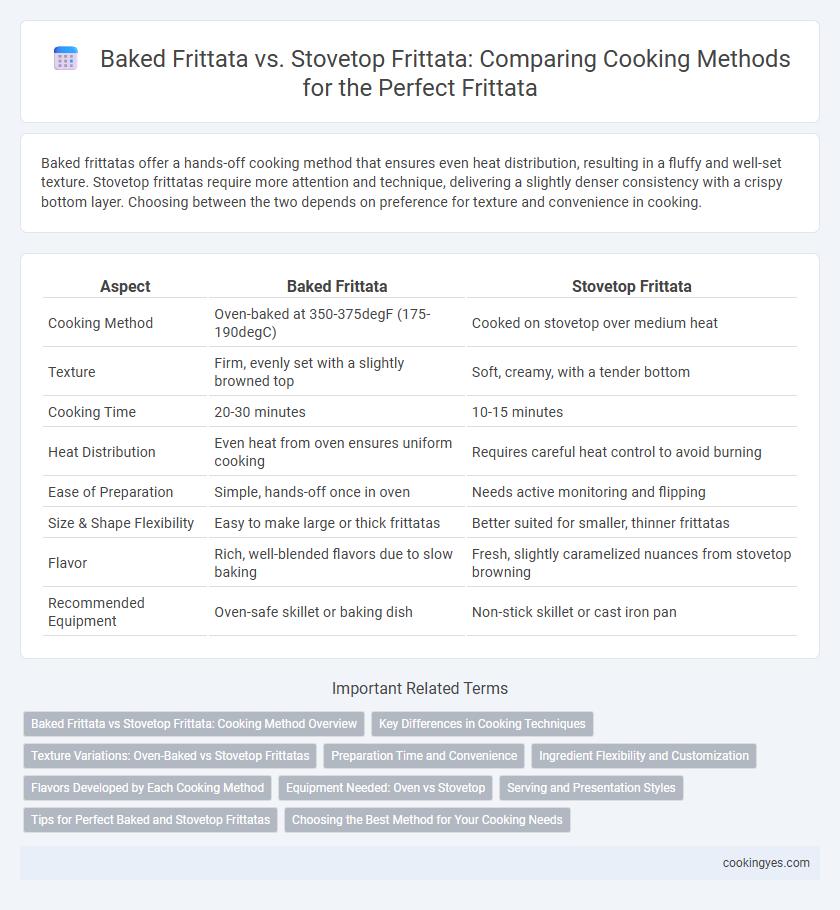Baked frittatas offer a hands-off cooking method that ensures even heat distribution, resulting in a fluffy and well-set texture. Stovetop frittatas require more attention and technique, delivering a slightly denser consistency with a crispy bottom layer. Choosing between the two depends on preference for texture and convenience in cooking.
Table of Comparison
| Aspect | Baked Frittata | Stovetop Frittata |
|---|---|---|
| Cooking Method | Oven-baked at 350-375degF (175-190degC) | Cooked on stovetop over medium heat |
| Texture | Firm, evenly set with a slightly browned top | Soft, creamy, with a tender bottom |
| Cooking Time | 20-30 minutes | 10-15 minutes |
| Heat Distribution | Even heat from oven ensures uniform cooking | Requires careful heat control to avoid burning |
| Ease of Preparation | Simple, hands-off once in oven | Needs active monitoring and flipping |
| Size & Shape Flexibility | Easy to make large or thick frittatas | Better suited for smaller, thinner frittatas |
| Flavor | Rich, well-blended flavors due to slow baking | Fresh, slightly caramelized nuances from stovetop browning |
| Recommended Equipment | Oven-safe skillet or baking dish | Non-stick skillet or cast iron pan |
Baked Frittata vs Stovetop Frittata: Cooking Method Overview
Baked frittatas cook evenly in the oven, allowing for a fluffy texture and consistent doneness throughout, while stovetop frittatas require careful heat control to avoid burning the bottom and undercooking the center. The baking method offers hands-off cooking with an ability to incorporate various ingredients that meld together as they cook slowly under consistent heat. Stovetop frittatas typically cook faster but demand frequent attention to achieve the right balance of tenderness and browning.
Key Differences in Cooking Techniques
Baked frittatas are cooked in the oven, allowing even heat distribution and a firm, custard-like texture with a slightly browned top, while stovetop frittatas rely on direct heat and often require careful flipping or broiling to avoid burning. The baking method enables hands-off cooking with consistent results, whereas stovetop preparation demands close attention and control over heat to achieve a fully cooked interior without overcooking the base. Differences in heat source and cooking duration between oven and stovetop impact texture, moisture retention, and overall flavor development.
Texture Variations: Oven-Baked vs Stovetop Frittatas
Oven-baked frittatas develop a firm, evenly cooked texture with a golden, slightly crispy top, enhancing the contrast between tender eggs and added ingredients. Stovetop frittatas tend to have a softer, creamier interior with a lightly browned bottom, offering a more custard-like consistency. The baking method allows for a uniform rise and set, while the stovetop approach results in varied textures between the edges and center.
Preparation Time and Convenience
Baked frittatas require longer preparation and cooking times, typically around 25-35 minutes, but allow for hands-off cooking ideal for larger servings. Stovetop frittatas cook in about 10-15 minutes, offering faster results and easier monitoring but demand constant attention to prevent burning. Baked methods provide convenience for multitasking and consistent heat distribution, while stovetop methods excel in speed and direct control over cooking.
Ingredient Flexibility and Customization
Baked frittatas offer greater ingredient flexibility by accommodating a wide range of vegetables, cheeses, and meats evenly distributed in a hot oven, which enhances flavor blending and texture consistency. Stovetop frittatas allow for quick ingredient customization during cooking, enabling precise control over browning and softness by adjusting heat and stirring techniques. Both methods support diverse ingredient combinations, but baking excels in uniform cooking while stovetop provides more immediate adaptability.
Flavors Developed by Each Cooking Method
Baked frittatas develop a rich, evenly cooked flavor with a slightly caramelized top due to prolonged oven heat, enhancing the natural sweetness of vegetables and giving a firmer texture. Stovetop frittatas offer a more immediate, savory experience with a tender, custard-like interior and slight browning on the bottom, preserving the freshness of herbs and other delicate ingredients. The choice between baking and stovetop methods influences the depth and intensity of flavors, with baking emphasizing complexity and stovetop highlighting freshness.
Equipment Needed: Oven vs Stovetop
Baked frittatas require an oven-safe skillet or baking dish along with a reliable oven capable of maintaining consistent heat, making them ideal for evenly cooking and setting the egg mixture. Stovetop frittatas demand a non-stick or cast-iron skillet with a tightly fitting lid to ensure gentle heat distribution and proper cooking without over-browning the eggs. Oven cooking equipment provides hands-off, uniform heat, while stovetop preparation offers quicker, more controlled cooking but requires attentive temperature management.
Serving and Presentation Styles
Baked frittatas offer a firm, sliceable texture ideal for serving in neat, uniform wedges, making them perfect for buffet-style presentations and gatherings. Stovetop frittatas tend to be softer and more skillet-shaped, suited for rustic, family-style serving directly from the pan. The presentation of baked frittata often highlights a golden, crisped top, while stovetop versions showcase a tender, slightly browned surface that pairs well with fresh herbs and toppings.
Tips for Perfect Baked and Stovetop Frittatas
For a perfect baked frittata, preheat the oven to 350degF (175degC) and use an oven-safe skillet to ensure even cooking and a golden, firm texture. When making a stovetop frittata, cook it slowly over low heat and cover the pan to allow the eggs to set without burning the bottom. Incorporate dairy like cream or cheese to enhance creaminess, and avoid overmixing to maintain a fluffy consistency.
Choosing the Best Method for Your Cooking Needs
Baked frittatas offer even cooking and a fluffy texture, ideal for feeding larger groups or preparing ahead of time, while stovetop frittatas provide quicker preparation with a crisp bottom, perfect for small servings and immediate consumption. Oven-baking ensures consistent heat distribution, making it easier to customize with vegetables, meats, and cheeses without constant attention. Stovetop methods demand more active monitoring but allow for faster adjustments and flexibility, catering to cooks valuing speed and simplicity.
Baked Frittata vs Stovetop Frittata for cooking method Infographic

 cookingyes.com
cookingyes.com